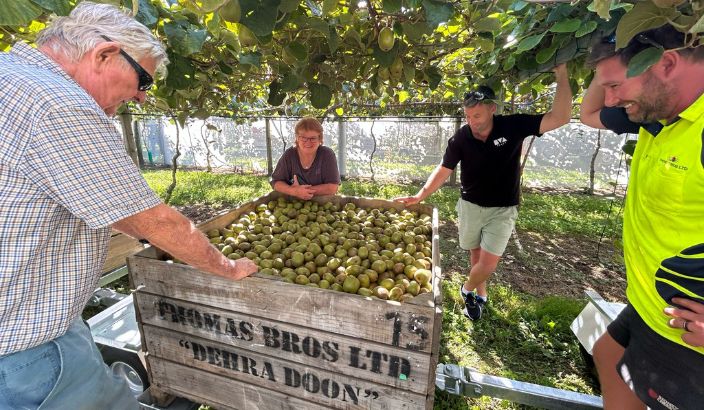First export of Tasman’s RubyRed kiwifruit

The first-ever harvest of RubyRed kiwifruit, with its vibrant ruby-coloured flesh, at Thomas Brothers Orchards in Riwaka. Photo: Zespri.
In a milestone for Tasman’s fruit industry, the first-ever export harvest of RubyRed kiwifruit has been successfully completed.
Known for its vibrant, ruby-coloured flesh, this new variety promises to bring a fresh burst of flavour and excitement to the global kiwi market.
Tasman growers are optimistic about its potential to a distinct place in the competitive kiwifruit market
“We’ve harvested and sold red kiwifruit before, but not the RubyRed variety, which is distinguished by its intense red colour and a flavour that’s a cross between a berry and a gold kiwifruit,” says Steve Thomas from Riwaka’s Thomas Brothers Orchards.
They planted their RubyRed vines a few years ago and have been carefully monitoring their growth. This year, they’ve harvested their first yield suitable for export.
“It’s exciting to grow something new, but there are plenty of challenges,” Steve explains.
“The RubyRed ripens differently from green or gold kiwifruit, requires different pollinators, and is sensitive to wind, so we’ve been building structures to protect them. Additionally, the fruit is relatively small, so we’ve been focusing on improving its size.”
Ian George from Griffin George Orcharding in Motueka shares that they’ve moved away from growing gold kiwifruit and instead planted 2.5 hectares of RubyRed.
“We wanted to try something new, and we believe RubyRed will grow very well here,” he says.
Ian adds that their orchard is part of a four-year RubyRed research project, currently in its first year, aimed at learning how to grow high-quality RubyRed.
“We’re collecting data that will help us better understand how to produce good-quality RubyRed with strong yields.”
The RubyRed is being exported to Asia-Pacific markets, including Japan and China, and the fruit will be available for the first time in the Philippines, Indonesia, Thailand, and the Pacific Islands.
While the RubyRed still has a low GI (glycemic index), it contains higher sugar levels compared to regular green or gold kiwis. Additionally, it has a delicate skin that makes it more prone to damage and spoilage during storage.
“The shorter shelf-life limits where it can be exported to. For instance, RubyRed wouldn’t make it to Europe in good condition,” Steve explains.
Ian notes that their first harvest yielded lower volumes, which was exactly as planned.
“We harvested our first export crop of 9,750 trays, which is low, but anticipated, as our focus was on establishing a strong canopy for the coming years.”
A kiwifruit canopy refers to how the vines are pruned and trained to grow, and it plays a crucial role in protecting the fruit from wind and frost.
Together, local RubyRed growers are working to expand their presence in the overseas market, diversify the varieties they grow to mitigate the risks posed by changing weather patterns, and increase local production volumes to 125,000 trays in the next two years, with vines already planted and maturing.
Their efforts aim to ensure a sustainable future for the industry.
